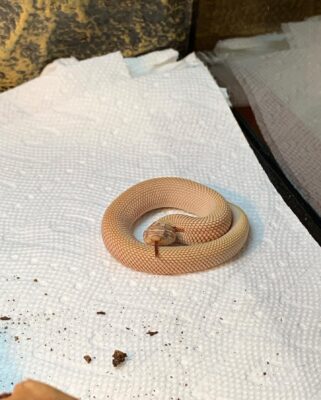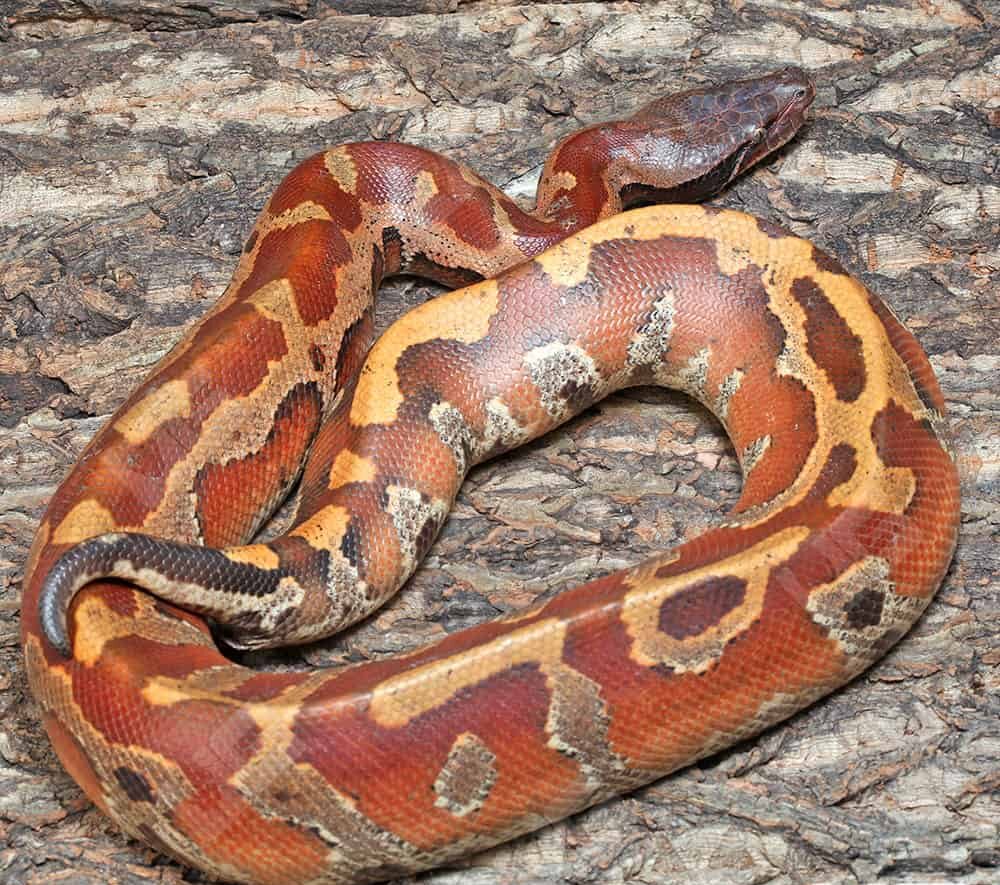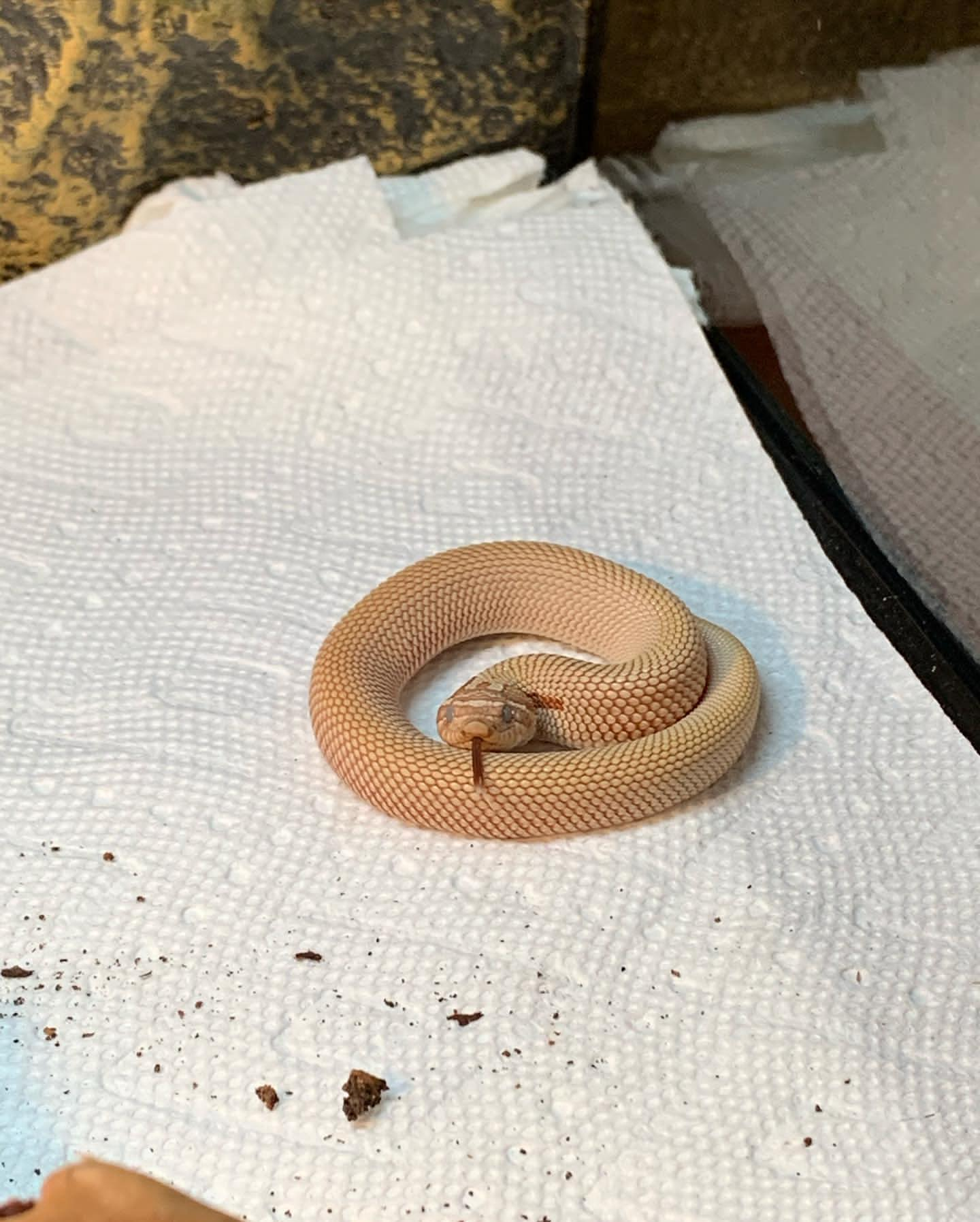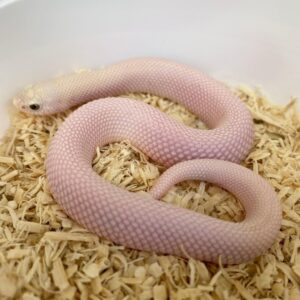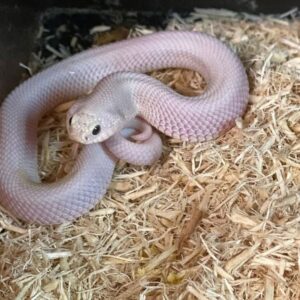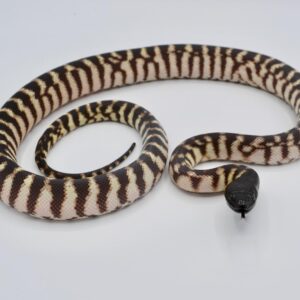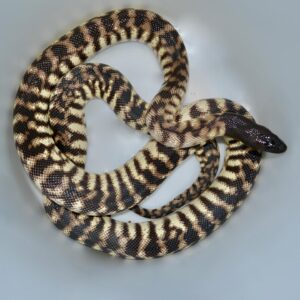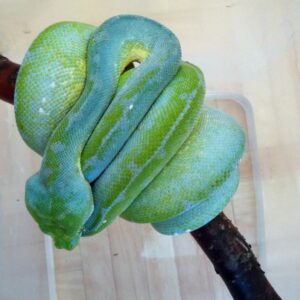Super Anaconda Hognose For Sale
$490.00
Super Anaconda Hognose
Hides
A large enclosure allows you to have additional hiding places that will enable the Super Anaconda Hognose
to keep cover when feeling stressed. You can include a hide on the hot side and the cold front so that the snake can have different options.
Additionally, a large hide is easy to clean and sanitize. However, the hiding place should only accommodate a coiled hognose and not too big that it will not be usable.
You can also include extra items in the enclosure like logs and branches to make a cozy spot for the Super Anaconda Hognose
as you will often see your snake climbing on them. If you decide to keep the snake in a biologically active cage, you can include a nutrient fertile soil and clay mix. We recommend keeping the cage furniture simple.
Also, keep a sturdy, clean water bowl in the snake’s enclosure. It should be dense so that it doesn’t tip over and spill the water. The container should be disinfected regularly and changed every few days.
Description
The Super Anaconda Hognose, scientifically known as Heterodon nasicus, is a captivating species that has garnered attention among herpetology enthusiasts and snake breeders alike. Originating from North America, specifically the central United States and northern Mexico, this unique reptile thrives in a variety of habitats, ranging from prairies and grasslands to sandy, arid regions. Its adaptability to diverse environments contributes to its widespread distribution and fascinating ecological presence.
One of the most distinguishing features of the Super Anaconda Hognose is its remarkable coloration and pattern, which sets it apart from other members of the hognose family. This snake exhibits a striking blend of greenish-brown and black markings, reminiscent of the patterns found on an anaconda, hence its name. The intricate, almost mosaic-like design not only enhances its visual appeal but also serves as a form of camouflage, aiding in its survival in the wild.
In addition to its distinctive appearance, the Super Anaconda Hognose is renowned for its unique behavioral traits. Unlike many other snake species, it has a relatively docile temperament, making it a popular choice for reptile enthusiasts looking for a manageable and visually stunning pet. Furthermore, its ability to mimic a cobra by flattening its neck and hissing when threatened adds an element of intrigue to its behavior, although it is generally non-aggressive and rarely bites.
The Super Anaconda Hognose is not only a marvel of nature but also a subject of ongoing research and interest within the scientific community. Its varied habitat, distinctive physical characteristics, and unique behaviors contribute to its status as a fascinating and valuable species in the world of herpetology.
Physical Characteristics
The Super Anaconda Hognose is a captivating species, distinguished by its unique physical traits that set it apart from other snakes. One of the most notable features is its size, with adult males typically reaching lengths of 2 to 3 feet, while females can grow slightly larger, often exceeding 3 feet. This species exhibits a robust and stout body, which is accentuated by its distinctive scale texture. The scales of the Super Anaconda Hognose are keeled, giving them a rough and textured appearance, which is both visually striking and tactilely unique.
The coloration of the Super Anaconda Hognose is another defining characteristic. These snakes boast a fascinating array of colors that can range from shades of olive green to a more muted brown, interspersed with darker blotches and spots. It is this anaconda-like pattern that lends the snake its name. The intricate patterns and coloration provide excellent camouflage in their natural habitat, allowing them to blend seamlessly with the surroundings. The belly of the Super Anaconda Hognose is typically lighter, often a stark white or cream, which contrasts sharply with its darker dorsal side.
Sexual dimorphism is present in the Super Anaconda Hognose, with females generally being larger and more robust compared to males. Additionally, females often display more pronounced patterns and coloration. Variations can also be observed among different individuals, with some exhibiting more vivid colors and sharper patterns, while others might have a more subdued appearance. These variations make each Super Anaconda Hognose unique, adding to the allure of this fascinating snake.
Overall, the physical characteristics of the Super Anaconda Hognose make it a remarkable species. Its size, textured scales, and anaconda-like pattern, along with the noticeable differences between males and females, contribute to its intriguing presence in the world of reptiles.
Behavior and Temperament
The Super Anaconda Hognose is a remarkable snake species, renowned for its unique behaviors and temperament. In the wild, these snakes exhibit a range of fascinating traits. A notable defensive behavior is hooding: when threatened, the Super Anaconda Hognose will flatten its neck to resemble a cobra, an impressive display meant to deter potential predators. This mimicry is not merely for show; it is a testament to the adaptability and survival instincts of the species.
Another intriguing behavior is thanatosis, or playing dead. When faced with persistent threats, the Super Anaconda Hognose may perform an elaborate act of feigning death. This involves rolling onto its back, opening its mouth, and even emitting a foul smell to convince predators that it is no longer a viable meal. This dramatic display is both a fascinating and effective survival strategy.
In captivity, the Super Anaconda Hognose is known for its relatively docile and manageable nature. This temperament makes them highly popular among reptile enthusiasts. They are generally curious and can become quite accustomed to human interaction with consistent, gentle handling. It is important to note, however, that like all reptiles, individual temperaments can vary. Some may exhibit more defensive behaviors if they feel threatened or stressed.
Overall, the Super Anaconda Hognose is a captivating species, both in the wild and as a pet. Their unique defensive behaviors, such as hooding and playing dead, are not only fascinating to observe but also highlight their natural adaptability. Their generally calm demeanor in captivity further cements their status as a favored choice among reptile aficionados.
Habitat and Enclosure Requirements
The Super Anaconda Hognose, a captivating reptile, thrives in specific environmental conditions that mirror its natural habitat. Native to regions characterized by sandy soils and sparse vegetation, these snakes are accustomed to arid or semi-arid landscapes. Replicating these conditions in captivity is vital for the health and well-being of the Super Anaconda Hognose.
When setting up an enclosure, size is a critical factor. For a single adult Super Anaconda Hognose, a minimum enclosure size of 20 gallons is recommended, though larger is always better. This allows ample space for the snake to move and explore, promoting physical and mental stimulation. A secure lid is essential to prevent escapes, as these snakes can be quite adept at finding ways out.
The choice of substrate is another important consideration. Given their natural inclination to burrow, substrates such as aspen shavings, cypress mulch, or a sand-soil mix are ideal. These materials not only facilitate burrowing but also help maintain appropriate humidity levels. Avoid substrates that can retain too much moisture, as excessive humidity can lead to health issues.
Temperature regulation within the enclosure is crucial. Establishing a temperature gradient, with a warm side ranging from 85-90°F and a cooler side around 70-75°F, allows the Super Anaconda Hognose to thermoregulate effectively. This can be achieved using under-tank heaters or heat lamps. Nighttime temperatures can drop slightly but should not fall below 65°F. Additionally, ambient humidity should be maintained between 30-50%, reflecting their natural arid habitats.
Enclosure decorations play a significant role in creating a stimulating environment. Providing hiding spots, such as cork bark or commercially available hides, helps the snake feel secure. Adding branches and rocks can also encourage natural behaviors like climbing and basking. Plants, whether live or artificial, can enhance the enclosure’s aesthetic and provide additional cover.
By meticulously replicating the Super Anaconda Hognose’s natural habitat, owners can ensure their snake remains healthy and comfortable in captivity, ultimately leading to a more enriching and fulfilling experience for both the snake and the keeper.
Diet and Feeding
The Super Anaconda Hognose, a captivating member of the reptile world, has a diet that varies depending on whether it is in the wild or captivity. Understanding its dietary requirements is crucial for ensuring its health and well-being.
In the wild, the Super Anaconda Hognose primarily consumes amphibians, particularly toads, which are a significant part of its natural diet. These snakes have evolved to handle the toxins present in their prey, making them unique in their feeding habits. Additionally, they may also feed on small mammals, birds, and other reptiles, depending on availability and habitat.
When kept in captivity, the dietary needs of the Super Anaconda Hognose can be met through a well-structured feeding regimen. It is advisable to provide them with a diet consisting mainly of appropriately sized rodents, such as mice and rats. These prey items should be offered every 5 to 7 days for juveniles and every 7 to 10 days for adults. It is essential to ensure that the prey size is proportionate to the snake’s size to prevent potential health issues.
Special dietary considerations include the occasional supplementation of amphibians or reptile-specific vitamins to mimic their natural diet more closely. However, it is crucial to consult a herpetologist or veterinarian before making any significant changes to their diet. Additionally, hydration is vital for their digestion, so fresh water should always be available.
Feeding challenges may arise, such as refusal to eat or regurgitation. These issues can often be addressed by adjusting the feeding schedule, ensuring the prey is appropriately sized, or checking environmental conditions. Stress and improper husbandry are common culprits behind feeding problems.
Overall, the key to maintaining a healthy Super Anaconda Hognose lies in understanding its natural dietary preferences and replicating them as closely as possible in captivity. Proper nutrition, along with regular monitoring of feeding habits, will contribute significantly to the longevity and well-being of these fascinating snakes.
Health and Common Diseases
The Super Anaconda Hognose, while generally hardy, can be susceptible to a range of health issues that are important for owners to recognize and address promptly. One of the most common health concerns is respiratory infections, which can manifest through symptoms such as wheezing, mucus discharge from the nose, and lethargy. These infections are often caused by inadequate humidity levels or poor ventilation in their habitat. Preventative measures include maintaining optimal humidity and providing a clean, well-ventilated environment.
Another prevalent issue is parasitic infestations, both internal and external. Internal parasites, such as worms, can lead to weight loss and digestive problems, while external parasites like mites can cause skin irritation and stress. Regular fecal examinations and skin inspections are crucial in early detection and treatment. Administering antiparasitic medications as prescribed by a reptile-savvy veterinarian can effectively manage these infestations.
Shedding problems, or dysecdysis, are also common among Super Anaconda Hognose snakes. Incomplete or problematic shedding can result from insufficient humidity or underlying health issues. Signs include retained eye caps and patches of old skin. Ensuring that the snake’s enclosure has the right humidity levels and providing a rough surface for the snake to rub against can facilitate proper shedding.
Moreover, metabolic bone disease (MBD) can be a significant concern, particularly if the snake’s diet lacks sufficient calcium or Vitamin D3. Symptoms of MBD include soft or swollen jawbones, lethargy, and difficulty moving. A balanced diet that includes calcium supplements and exposure to appropriate UVB lighting are key preventative measures against MBD.
Regular veterinary check-ups are indispensable for the overall well-being of the Super Anaconda Hognose. Early detection through routine examinations can prevent minor issues from escalating into severe health problems. Proper care, including a well-maintained habitat and a balanced diet, is fundamental in ensuring the snake’s longevity and health.
Breeding Super Anaconda Hognoses
Breeding Super Anaconda Hognoses is an intricate process that requires a thorough understanding of their natural behaviors and reproductive cycle. To start, selecting a compatible breeding pair is crucial. Ensure both the male and female are healthy, of appropriate age, and exhibit desirable traits. It’s recommended to have a veterinarian check-up to confirm their fitness for breeding. Proper conditioning of the breeding pair through optimal diet and environment is essential. Gradually increasing the feeding frequency can help in preparing the female for the energy demands of reproduction.
The reproductive cycle of Super Anaconda Hognoses is marked by distinctive stages. As the breeding season approaches, hognoses undergo a period known as brumation, akin to hibernation, which typically lasts for a few months. During this time, it’s vital to maintain a stable, cooler temperature to simulate natural conditions. After brumation, gradually increase the temperature to signal the end of the dormancy period. Courtship usually follows, with the male showing interest in the female through various behaviors such as nudging and coiling.
Once mating occurs, the female will need a suitable nesting area to lay her eggs. Providing a nesting box with moist substrate, like sphagnum moss or vermiculite, will create an ideal environment for egg deposition. The female usually lays between 10 to 20 eggs, which should be carefully transferred to an incubator set at a consistent temperature of around 82-84°F. Humidity levels should be monitored to prevent desiccation of the eggs.
Eggs typically hatch after 50 to 60 days, and it’s critical to maintain a controlled environment for successful incubation. Once the hatchlings emerge, they should be placed in individual enclosures to prevent stress and competition. Initial feeding can be challenging, as young hognoses may be reluctant to eat. Offering appropriately-sized prey and ensuring a calm environment can encourage feeding behavior. Regular monitoring and gentle handling will aid in the healthy growth and development of the hatchlings.
Breeding Super Anaconda Hognoses can be a rewarding endeavor, but it does come with challenges. Patience, meticulous care, and a comprehensive understanding of their needs are essential for a successful breeding experience.
Conclusion and Final Tips
In exploring the fascinating world of the Super Anaconda Hognose, we have delved into various aspects of this unique and captivating snake. From its distinctive physical characteristics to its specific care requirements, it is evident that owning a Super Anaconda Hognose can be a rewarding experience. This species, with its striking appearance and intriguing behaviors, requires a dedicated and informed approach to ensure its well-being.
For those interested in keeping or breeding Super Anaconda Hognoses, it is essential to start by sourcing these snakes from reputable breeders or specialized reptile stores. Ensuring the health and genetic integrity of the snake is paramount, so thorough research and verification of the seller’s credentials are recommended. Additionally, connecting with established reptile communities and forums can provide valuable insights and recommendations for trustworthy sources.
Proper care involves maintaining an appropriate habitat that mimics the snake’s natural environment, providing adequate heating, humidity, and space. A well-balanced diet, primarily consisting of appropriately sized rodents, is crucial for their growth and health. Regular monitoring and vet check-ups will help in early detection of any health issues, ensuring the snake’s longevity.
For continued education, numerous resources are available that can enhance your knowledge and skills in handling Super Anaconda Hognoses. Books, online courses, and workshops conducted by herpetology experts offer in-depth information and practical advice. Staying informed about the latest research and developments in reptile care will contribute significantly to responsible ownership.
Ultimately, owning a Super Anaconda Hognose is a commitment that requires patience, dedication, and a genuine interest in their well-being. By adhering to the best practices and continuously educating oneself, enthusiasts can ensure that these remarkable creatures thrive in captivity.
